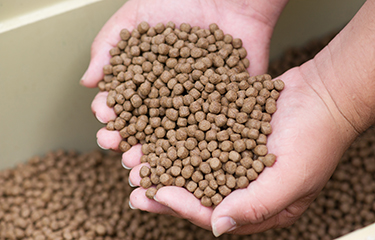Russian aquaculture hopes science will give it a feed advantage

Back in 2017, a fish feed plant of Karelskiye Rybnye Korma (Karelian Fish Feeds) was inaugurated in the Republic of Karelia. MK Karelia, the local newspaper, was invited to cover the inauguration ceremony, but it received a rather unexpected wish from the plant’s owners: it was forbidden to take pictures of the equipment.
According to the company, critical to its efforts to formulate a successful fish feed for Arctic char was an ingredient that allows the feed to float in water without sinking, or staying on the surface. The company managed to find this ingredient, previously exclusively known to foreign producers, and wanted to refrain from having photos of the equipment go public in order to keep its findings secret.
New aquafeed start-ups are popping up across Russia, boosted by a governmental effort to supply the domestic market with quality, affordable fish. These new companies are following that trend as they forge ahead with efforts to replace imported fish feeds with local produced ones for the country’s growing aquaculture sector.
Another aquafeed firm, Fish Feeds in Astrakhan also has its own feed formulations based on research, which promotes an increased rate of protein digestibility as its strength in competing with imports.
Fish-feed production is a highly technical business, so scientific knowledge is key to developing effective feeds. That’s where Russia may have an advantage, as it has a robust fishery science program funded by the state steadily since Soviet times.
The press service of the Pacific Fishery Scientific Research Center (TINRO) said earlier this year that scientists finished trials of experimental feeds that turned out to be more productive and cheaper than imported ones.
The trials conducted at two farms in Russia’s Far East showed that Russia-invented nutrients cost just RUB 200 (USD 2.70, EUR 2.28) per kilogram, 10 percent cheaper than those of competitors. They were also proven to be of higher efficiency, as their protein and other important components were not being washed out by water, which results in reduced consumption.
TINRO’s scientists have developed new formulations of protein, peptides, and amino acids based on the natural needs of chum and sturgeon that does not require state-of-art equipment or hard-to-obtain components, TINRO said.
"Nowadays, more than half of the starting feeds consumed in Russia are imported. However, for securing stable development of the aquaculture sector the development of domestic feeds is essential,” the press release said.
Within the past year, Russia has doubled down on its push to source more of its aquaculture feed domestically as the sector expands. Currently, the country does not produce enough feed to meet the demands of its aquaculture sector, but investment and boosts from the country’s government could change that soon.
Photo courtesy of Choksawatdikorn/Shutterstock






Share